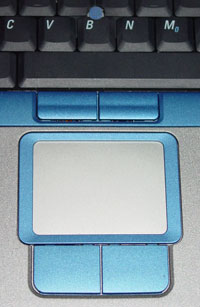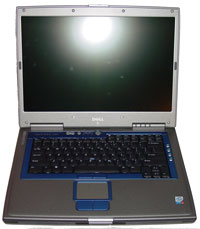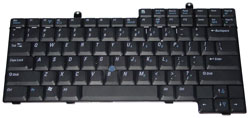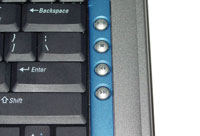Dell Inspiron 8600: Mobile Multimedia goes Wide Screen
by Andrew Ku on October 9, 2003 1:00 AM EST- Posted in
- Laptops
Construction — Build, Appearance, Size
As the successor to the Inspiron 8500, the Inspiron 8600 has the same basic form as its predecessor. However, it is uses Centrino components instead of mobile components. For example, the Inspiron 8600 uses a Pentium-M processor in contrast to the 8500's Pentium 4-M processor. In traditional Dell fashion, the Inspiron 8600 comes in a Moonlight Silver and Venice Blue color scheme. To access the notebook, push the single clip that secures the lid and open.Click to enlarge.
Upon access, the 8600 reveals a 15.4" WUXGA (1920x1200) screen, which is one of three options available for the Inspiron 8600 and 8500. Since Dell offers customizable systems, there are two other available options: WXGA and WSXGA+ with the latter being the default option for the Inspiron 8600/8500. The two other available options use the same screen size, 15.4", but are limited to lower resolutions: 1280x800 and 1680x1050, respectively. Considering the size of the notebook, a 15.4" wide screen is good choice for Dell to make, as a larger wide aspect screen can't really fit. Our recommendation would be to stick with the WSXGA+ (1680x1050) as the bottom limit for your configuration, as a WXGA (1280x800) looks a bit odd on a 15.4" wide aspect screen.
For those looking for a large amount of workspace or that extra kick for watching movies, the 15.4" WUXGA (1920x1200), which is the option we personally prefer, won't disappoint you. To be specific, the 15.4" WUXGA provides 20% more desktop surface than a typical 15.4" UXGA, and with UltraSharp LCD technology, the 15.4" WUXGA gives us wider and clearer viewing angles.
In order for Dell to fit the 15.4" panel on the Inspiron 8600, the notebook has a wider berth that we have yet to see many other notebooks surpass. Traditional notebooks have been square or at least near square in design, but with the wide screen panel, the Inspiron 8600 basic form is rectangular (3.3 inches greater in width than length). This gives the 8600 plenty of surface space to spare and carries over to keyboard layout.
Overall, Dell has gotten the keyboard down right. The rectangular form has given Dell plenty of surface space with which to work, and the 8600 is equipped appropriately with a full-sized keyboard. The control key is at the correct place on the keyboard (bottom left corner) and included dedicated arrow keys. The keyboard feels fairly standard, which we found to have a good response and a tactile feel.
Click to enlarge.
Since the notebook is offered as a multimedia platform, Dell has appropriately designed a few multimedia hotkeys for quick access. While the function key on the keyboard takes care of this for other notebooks, the dedicated keys provide simplified support.
Click to enlarge.
There are two methods to which mouse input is supplied, dubbed the “DualPoint” integrated pointing device. Like the Latitude D800, the “DualPoint” input system comprises of a touchpad and a track stick. The set of buttons for the touchpad are reasonably responsive, but we found the set for the track point a bit fickle. We would have liked to have seen a bit more response in them when we pressed down to enable a click. Still missing is a scroll button of sorts. This is also missing from the Inspiron 8500 and the 8200, which the 8600 succeeds.

There are four status LEDs on the monitor hinge. This is a good placement for the LEDs because it maintains visibility even when the monitor is closed, which provide status information on power, hard drive activity, battery state, and Bluetooth status. Additionally, this placement negates the need for an extra array of LEDs specifically to be visible when the monitor is closed. We especially liked the fade on the power and the battery state LEDs when they changed status. Instead of the light abruptly going on and off, the light would do a simple fade, which we found to add that little something extra.

Additional status LEDs are located above the keyboard and indicate key status (num lock, caps lock, and scroll lock). The system's power button is located to the right of the LEDs, and to the left is the mute button followed by a volume up and volume down button, which should come in handy when you are playing movies. The little divot above the caps lock (the middle LED) is actually the system microphone. This is a good placement in terms of keeping hands away from creating the unwanted rustling noise, but it also leaves it a bit too far away from the sound source (our mouth).

When the screen is visible, the 8600 exposes two of its cooling vents. The first of the two is located towards the back of the system, near the monitor, and to the left of the keyboard. This brings in cool air for the CPU fan, which lies directly below. The second vent is barely visible and is located directly below the monitor along the gap between the monitor and the system (between the two hinges). This is an exhaust vent for a second cooling fan that is for a separate component, which we will cover later on.













21 Comments
View All Comments
Andrew Ku - Saturday, October 11, 2003 - link
Hey bud :), I don't recall 386 processors in notebooks that used sockets... In fact, only recently have notebooks on such a wide scale used molex socket designs to house processors, and this is more for the ease of scalability and or the need to use desktop components. Remember that when you are talking about the mobile side of pcs, often times it becomes an entirely different ball park than when compared to the desktop side.Btw, if you are refering to the use of "molex," it is a technically correct term. Additionally, we did not write "molex connectors." If you read page 4, you will see that we instead wrote "molex socket."
Anonymous User - Saturday, October 11, 2003 - link
I just wonder when CPU's went from using sockets ," as they have done since the 386" , to using molex connectors as refered to in the article , should technical writers proof read more ????bandwidthboy
Anonymous User - Friday, October 10, 2003 - link
The 7200 rpm uses less power if used over time..indicated by the write wattage.Here's a quick comparison of wattage use from the previous 60GB/5400 rpm model vs the 7K60/7200 rpm model:
60GB/5400 RPM vs 60GB/7200 RPM:
Max (startup/spinup) - 5W vs 5.5W
Seek (avg): 2.6W for both
Read (avg): 2.5W for both
Write (avg): 2.7W vs 2.5W
(7K60 slightly lower)
Performance idle (avg): 2.0W for both
Active idle (avg): 1.3W for both
Sleep: 0.1W for both
Anonymous User - Friday, October 10, 2003 - link
well if you guys are looking for m10's in laptops you can try looking here:http://atitech.com/buy/onboard/mobile/mobilityrade...
you can also try http://pctorque.com, they have the same laptops as some of the ones on the ati site but a little cheaper i think (plus there's one that has an option for a 2x dvd-rw drive and a built in tv tuner :) (that's if you're willing to dish out upwards in about $3000US for it
Anonymous User - Friday, October 10, 2003 - link
# 4 If you want quality settings like FSAA & Aniso the ATI is much..much.. better.Also 2D graphics quality is on the ATI A LOT better!!
Anonymous User - Thursday, October 9, 2003 - link
He meant for a monitor only, read more carfullyAnonymous User - Thursday, October 9, 2003 - link
# 2 try 2300.00 w/out a M10Anonymous User - Thursday, October 9, 2003 - link
Actually they are not nearley that expensive for the 17" wide screens. Samsung has one of the best, the 172w.http://www.newegg.com/app/viewproduct.asp?DEPA=1&a...
Well, I have a 8600 on the way, wont ship until early november because dell claims the 1920x1200 screens will not be in until OCt 28.
Anonymous User - Thursday, October 9, 2003 - link
I totally agree on the fact that Dell should offer a notebook with the Ati M10(p) !!!...I live in Belgium ( Europe ) an dcannot find a "known" brand with an ATI M10(p) offer...
Anonymous User - Thursday, October 9, 2003 - link
Yes there out there but pricey, a 17" $700 -800 on up...